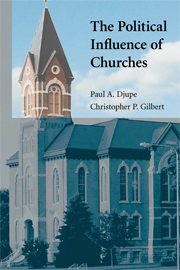Book contents
- Frontmatter
- Contents
- Acknowledgments
- Introduction: A Theory of Religious Influence on Political Behavior
- 1 Social Networks and Church Structure
- 2 Clergy Influences and Religious Commitment Reconsidered
- 3 Church-Centered Influences on Public Opinion
- 4 The Resourceful Believer
- 5 The Construction of Political Mobilization in Churches
- 6 Present but Not Accounted for?
- 7 Conclusion
- Appendix: Variable Coding
- References
- Index
5 - The Construction of Political Mobilization in Churches
Published online by Cambridge University Press: 05 June 2012
- Frontmatter
- Contents
- Acknowledgments
- Introduction: A Theory of Religious Influence on Political Behavior
- 1 Social Networks and Church Structure
- 2 Clergy Influences and Religious Commitment Reconsidered
- 3 Church-Centered Influences on Public Opinion
- 4 The Resourceful Believer
- 5 The Construction of Political Mobilization in Churches
- 6 Present but Not Accounted for?
- 7 Conclusion
- Appendix: Variable Coding
- References
- Index
Summary
social scientists have studied the democratic nature of citizen political participation from two principal angles. The dominant approach begins with social inequality, focusing on the unequal distribution of resources and how such inequities may be remedied through civil society. Verba, Schlozman, and Brady (1995) articulate the primary explanatory framework in their civic voluntarism model: civic resources, personal engagement, and social recruitment are generally necessary features to push people into the political process. Subsequent research has augmented their findings, tweaking the emphasis on one feature or another or exploring how the dynamics of acquiring politically relevant resources vary for different subsets of the population (Ayala 2000; Brown and Wolford 1994; Burns, Schlozman, and Verba 2001; Djupe and Grant 2001; Musick, Wilson, and Bynum 2000; Schlozman, Burns, and Verba 1994, 1999; Schlozman et al. 1995; Verba et al. 1993; Verba, Burns, and Schlozman 1997). Research in this field has identified churches as a particularly important source of civic skills that help to subsidize resource deficits, largely through practical leadership experiences (Cassel 1999; Leege 1988; Peterson 1992; but see Djupe and Grant 2001) and augmented engagement (Calhoun-Brown 1996; Harris 1999; Hougland and Christenson 1983).
The other major line of research on political participation stems from concerns about citizenship quality and questions about difference – to sustain democracy, citizens must deliberate to ascertain their interests and the best solutions to public problems.
- Type
- Chapter
- Information
- The Political Influence of Churches , pp. 177 - 210Publisher: Cambridge University PressPrint publication year: 2008
- 1
- Cited by

